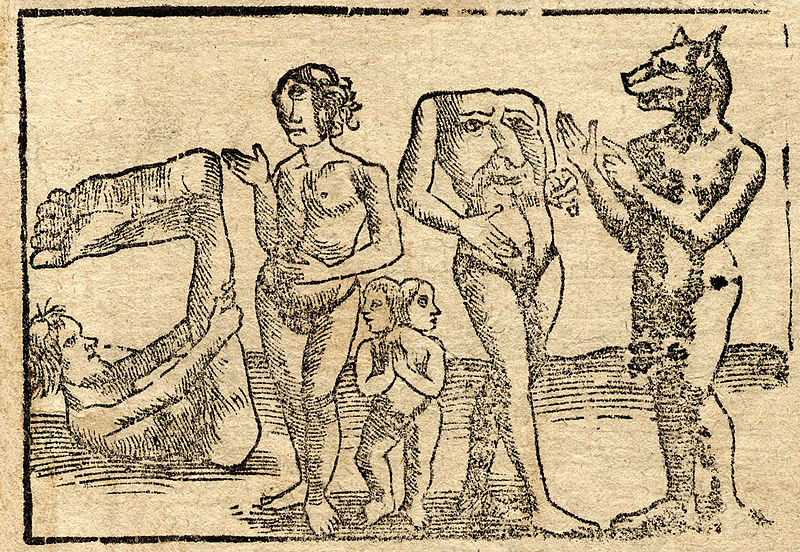 Submitted by Rifkin the Historian on
Submitted by Rifkin the Historian on

Sebastian Münster,1544, Public domain, via Wikimedia Commons
Columbus believed he would find ‘blemmyes’ and ‘sciapods’ – not people – in the New World ...
In 1492, when Christopher Columbus crossed the Atlantic Ocean in search of a fast route to East Asia and the southwest Pacific, he landed in a place that was unknown to him. There he found treasures – extraordinary trees, birds and gold.
But there was one thing that Columbus expected to find that he didn’t.
Upon his return, in his official report, Columbus noted that he had “discovered a great many islands inhabited by people without number.” He praised the natural wonders of the islands.
But, he added, “I have not found any monstrous men in these islands, as many had thought.”
Why, one might ask, had he expected to find monsters?
My research and that of other historians reveal that Columbus’ views were far from abnormal. For centuries, European intellectuals had imagined a world beyond their borders populated by “monstrous races.”
Of course the ‘monstrous races’ exist
One of the earliest accounts of these non-human beings was written by the Roman natural historian Pliny the Elder in 77 A.D. In a massive treatise, he told his readers about dog-headed people, known as cynocephalus, and astoni, creatures with no mouth and no need to eat.
Across medieval Europe, tales of marvelous and inhuman creatures – of cyclops, blemmyes, creatures with heads in their chests, and sciapods, who had a single leg with a giant foot – circulated in manuscripts hand-copied by scribes who often embellished their treatises with illustrations of these fantastic creatures.
Though there were always some skeptics, most Europeans believed that distant lands would be populated by these monsters, and stories of monsters traveled far beyond the rarefied libraries of elite readers.
For example, churchgoers in Fréjus, an ancient market town in the south of France, could wander into the cloister of the Cathédrale Saint-Léonce and study monsters on the more than 1,200 painted wooden ceiling panels. Some panels portrayed scenes of daily life – local monks, a man riding a pig and contorted acrobats. Many others depicted monstrous hybrids, dog-headed people, blemmyes and other fearsome wretches.
Perhaps no one did more to spread news of monsters’ existence than a 14th-century English knight named John Mandeville, who, in his account of his travels to faraway lands, claimed to have seen people with the ears of an elephant, one group of creatures who had flat faces with two holes, and another that had the head of a man and the body of a goat.
Scholars debate whether Mandeville could have ventured far enough to see the places that he described, and whether he was even a real person. But his book was copied time and again, and likely translated into every known European language.
Leonardo da Vinci had a copy. So did Columbus.
Old beliefs die hard
Even though Columbus didn’t see monsters, his report wasn’t enough to dislodge prevailing ideas about the creatures Europeans expected to find in parts unknown.
In 1493 – around the time Columbus’ first report began to circulate – printers of the “Nuremberg Chronicle,” a massive volume of history, included images and descriptions of monsters. And soon after the explorer’s return, an Italian poet offered a verse translation describing Columbus’ journey, which its printer illustrated with monsters, including a sciapod and a blemmye.
Indeed, the belief that monsters lived at the Earth’s edge remained for generations.
In the 1590s, the English explorer Sir Walter Raleigh told readers about the American monsters he heard about in his travels to Guiana, some of which had “their eyes in their shoulders, and their mouths in the middle of their breasts, & that a long train of haire groweth backward between their shoulders.”
Soon after, the English natural historian Edward Topsell translated a mid-16th-century treatise of the various animals of the world, a book that appeared in London in 1607, the same year that colonists established a small community at Jamestown, Virginia. Topsell was eager to integrate descriptions of American animals in his book. But alongside chapters on Old World horses, pigs and beavers, readers learned about the “Norwegian monster” and a “very deformed beast” that Americans called an “haut.” Another, known as a “su,” had “a very deformed shape, and monstrous presence” and was “cruell, untamable, impatient, violent, [and] ravening.”
Of course, in the New World, the gains for Europeans came at a terrifying cost for Native Americans: The newcomers stole their land and treasures, enslaved them, introduced Old World diseases and spurred long-term environmental change.
In the end, perhaps these indigenous Americans saw the invaders of their homelands as a ‘monstrous race’ of its own – creatures who destabilized their communities, took their possessions and threatened their lives.
Peter C. Mancall
This article is republished from http://thecoversation.com under a Creative Commons License. Read the original article https://theconversation.com/columbus-believed-he-would-find-blemmyes-and-sciapods-not-people-in-the-new-world-104306
